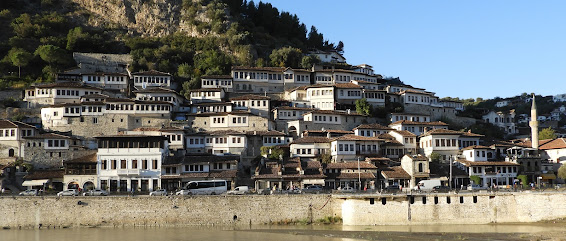 |
| Ottoman houses in Berat |
We left Gjirokastra yesterday morning to drive to Berat, another town with whitewashed Ottoman houses built on steep mountainsides on either side of the River Osum. On one side of the river, where we stayed, the city is renovating the cobblestone alleyways and putting water pipes underground. The hope is that the water tanks on everyone’s roof and the coils of electrical wires strung between houses will go underground also and clear out the messiness of this area of beautiful, old buildings. No vehicles can get up the alleyways, so donkeys haul materials up the mountainside for the restoration work and haul down the debris left over from all the digging.
 |
| Ottoman construction with wood layers |
We took a back road to get to Berat. The main roads are mostly very good, though
often a little narrow, but the back road was in bad condition. Still not a problem to drive. We had to watch for potholes which could
swallow a car and lots of bumps, but all that was very worth it because the
drive was so beautiful. We drove over mountains
and across valleys with vineyards and olive orchards. One large area obviously produced oil many
years ago. I saw only one oil well still
pumping, but the landscape is littered with rusted drilling towers from the
early part of the 20th century.
We saw a large pool of oil that badly needs to be cleaned up. We could smell it and the gas leaking from
uncapped wells throughout our drive through the area. A rusted oil refinery sits useless in one
valley, also smelling of gas and decay.
 |
| church at castle with Ottoman cloisenne design |
Like Gjirokastra, the old sections of Berat have running water only a couple of hours a day. Hence the water tanks on every roof in the historic part of the town. We climbed the very steep cobblestone alleys to the large castle on top of the mountain. The Greeks built the first castle, followed by the Byzantines and, later, the Ottomans. There are 3 huge cisterns inside the 3 walls of the fortress, enough to supply the garrison and townspeople during a siege. Today, 400 people still live inside the castle walls, but most of the former residents have moved to more comfortable homes in the town.
The old Ottoman houses were built of stone and plastered inside and out. About every 18 inches, they put a layer of wood for earthquake protection. Since they had nothing like cement, they mixed dirt and straw, like adobe, to use as mortar. That seemed to work well once there was plaster coating the outside of the building.
 |
| mountains above Berat |
Berat is about 50% Muslim and 50% Christian, though our guide told us no one goes to churches or mosques a lot. During the Communist era, religion was banished, mosques and churches were turned into hospitals, museums and other public buildings, and anyone espousing religious beliefs was punished severely. One of the old mosques right on the river still has the beautiful frescoes from the Ottoman era. Despite the Muslim prohibition on painting images, the Ottomans often painted scenes, animals and flowers on their mosques and public buildings.
 |
| fresco on mosque |

No comments:
Post a Comment